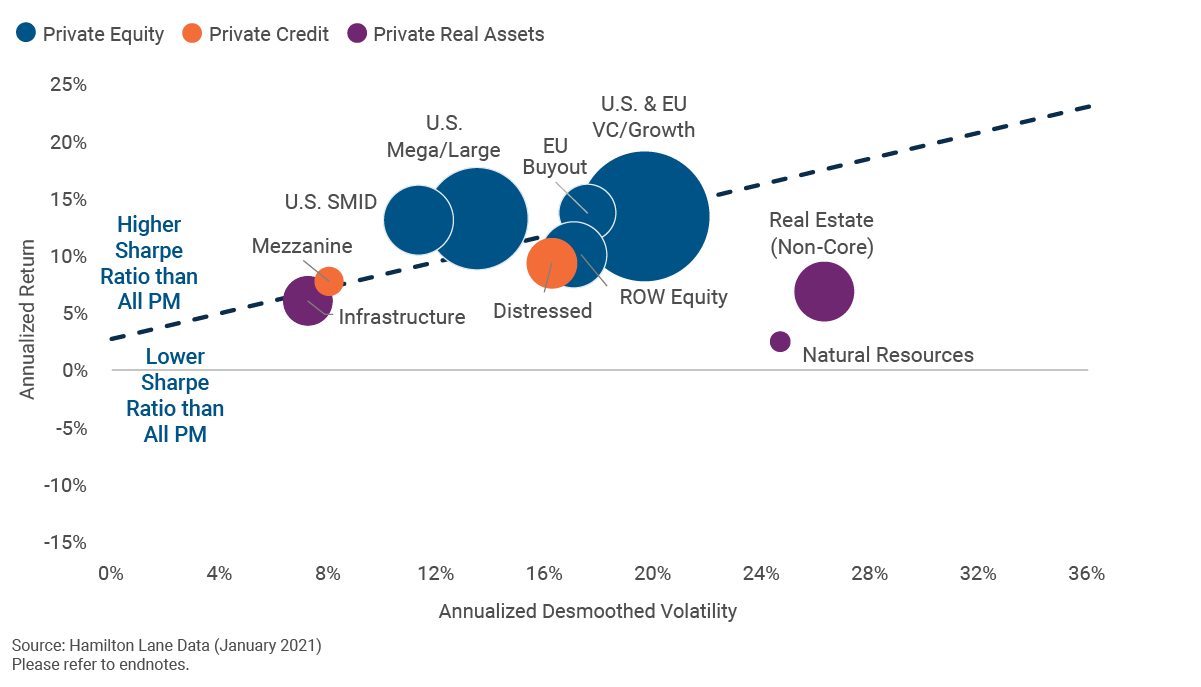
We’ve previously discussed the general aversion to measuring risk in the private markets. (Ok, fine, so we’re like the relative that sits at the holiday gatherings and tells the same joke every year. But, like that relative, we find it endlessly funny and so we’ll tell it again: Two GPs walk into the LP Bar & Grill and sit down with a group of LPs. One GP offers, “I have a 21% return and use 90% leverage,” while the second GP counters, “I have a 20% return and use no leverage.” They each proceed to hand out subscription documents for their next fund. Who receives the most subscriptions? Easy, the first GP because 21% is greater than 20%.)
A sense of the relative volatility and return of different strategies allows you to make more informed portfolio decisions.
15-Year Strategy Returns & Volatility
Bubbles Sized by NAV
Look at the range of factors here: What are your return objectives and how much risk do you want to take, or how much volatility are you willing to bear? Are you a large or small investor (because the size of the opportunity has a bearing on your ability to access it)? How will you blend these different features and profiles together?
Let’s stay with risk a moment.
Lowest Five-Year Annualized Performance
1995-2020
The above chart is the most under-appreciated chart in the overview. How often do we sit in meetings around boardroom tables — or how often did we used to anyway; these days we’re more likely sitting at dining room tables in our pajamas — hearing about the “risk” of private markets investing? What’s generally being discussed is the risk of loss. You hear it constantly: “These are risky investments and you can lose all your money.” Let’s cut to the chase: The real risk in the private markets is related to liquidity and upside capture; it is not related to risk of loss, particularly in buyout and credit. Look at the numbers for the worst five-year performance for private credit and developed markets buyout. You didn’t lose money. Understanding and assessing the risks you are taking is crucial to investing well in the private markets.
Endnotes
Chart 2.19: Infrastructure from 2000 – 2020, Natural Resources from 1998 – 2020.
Definitions
All Private Markets: Hamilton Lane’s definition of “All Private Markets” includes all private commingled funds excluding fund-of-funds, and secondary fund-of-funds.
Corporate Finance/Buyout: Any PM fund that generally takes control position by buying a company.
Credit: This strategy focuses on providing debt capital.
Distressed Debt: Includes any PM fund that primarily invests in the debt of distressed companies.
EU Buyout: Any buyout fund primarily investing in the European Union.
Infrastructure: An investment strategy that invests in physical systems involved in the distribution of people, goods, and resources.
Mega/Large Buyout: Any buyout fund larger than a certain fund size that depends on the vintage year.
Mezzanine: Includes any PM fund that primarily invests in the mezzanine debt of private companies.
Natural Resources: An investment strategy that invests in companies involved in the extraction, refinement, or distribution of natural resources.
Private Equity: A broad term used to describe any fund that offers equity capital to private companies.
Real Assets: Real Assets includes any PM fund with a strategy of Infrastructure, Natural Resources, or Real Estate.
Real Estate: Any closed-end fund that primarily invests in non-core real estate, excluding separate accounts and joint ventures.
VC/Growth: Includes all funds with a strategy of venture capital or growth equity.
Index Definitions
BofAML High Yield Index: The BofAML High Yield index tracks the performance of below investment grade U.S. dollar-denominated corporate bonds publicly issued in the U.S. domestic market
MSCI World Index: The MSCI World Index tracks large and mid-cap equity performance in developed market countries.
Credit Suisse Leveraged Loan Index: The CS Leveraged Loan Index represents tradable, senior-secured, U.S. dollar-denominated non-investment grade loans.
FTSE/NAREIR Equity REIT Index: The FTSE/NAREIT All Equity REIT Index tracks the performance of U.S. equity REITs.
MSCI World Energy Sector Index: The MSCI World Energy Sector Index measures the performance of securities classified in the GICS Energy sector.
S&P Global Infrastructure Index: The S&P Global Infrastructure Index tracks the performance of 75 companies from around the world that represent the infrastructure industry.
Disclosures
This presentation is not an offer to sell, or a solicitation of any offer to buy, any security or to enter into any agreement with Hamilton Lane or any of its affiliates. Any such offering will be made only at your request. We do not intend that any public offering will be made by us at any time with respect to any potential transaction discussed in this presentation. Any offering or potential transaction will be made pursuant to separate documentation negotiated between us, which will supersede entirely the information contained herein.
Any tables, graphs or charts relating to past performance included in this presentation are intended only to illustrate the performance of the indices, composites, specific accounts or funds referred to for the historical periods shown. Such tables, graphs and charts are not intended to predict future performance and should not be used as the basis for an investment decision.
The information herein is not intended to provide, and should not be relied upon for, accounting, legal or tax advice, or investment recommendations. You should consult your accounting, legal, tax or other advisors about the matters discussed herein.
As of February 16, 2021